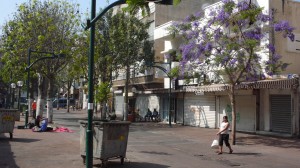It’s nine a.m. and the shops haven’t yet pulled up their shutters on this pedestrian shopping street down near the bus station. This is a corner of the city not much advertised, a relatively tidy bit of the Third World: note the profusion of dumpsters. The woman bringing out her morning trash is probably Filipina; many of them serve as domestic workers and caretakers to the elderly here. The guys in front of the shop are Africans–perhaps Ethiopian Jews, more likely refugees from the Sudan. A moment after I took this shot I walked on and passed behind the man spreading out his wares on the sidewalk. Looking down, I saw he had four metal staples clamped in his scalp–an apt emblem of the tenuous social fabric of this soi-disant “ Jewish State.”
Jewish State.”

I didn’t get the ” I saw he had four metal staples clamped in his scalp–an apt emblem of the tenuous social fabric of this soi-disant “Jewish State.”
The metal clamps were stitches after surgery? I fail to get both sides of the allegory implied here.
Is the moral here that Israel, the “self proclaimed” as your say, homeland of the Jews, was stapled by a stapler gun to the skalp of the arabs?
I’m just curious as to the origin of your associations.
The “soi-disant” is a mistake, as a friend pointed out to me: the UN Resolution establishing the State of Israel uses similar language, he noted. As for the staples, I meant that they were holding together what might otherwise stretch apart–for example, the various communities now geographically located within the State of Israel: Askenazim, Mizrachim, Arab citizens, Ethiopian citizens, Bedouin citizens, random Sudanese, Filapinas, and filipinas of many other nationalitites…not to mention the Palestinian Arabs (Christian or Muslim) now occupying space in the Occupied Territories which some claim as part of Israel. The vectors of these groups’ various interests are pulling in many directions, hence stretching the social fabric.